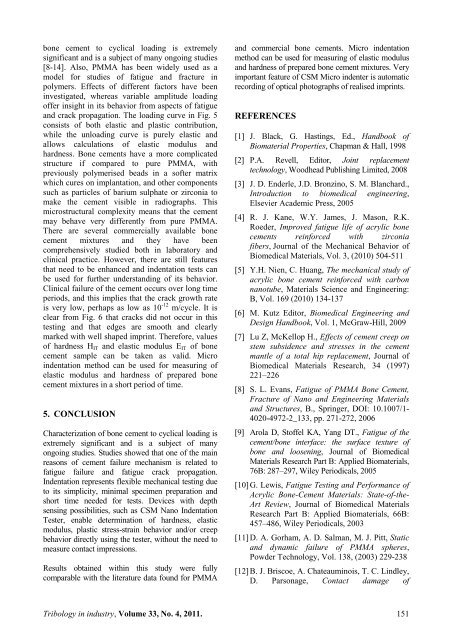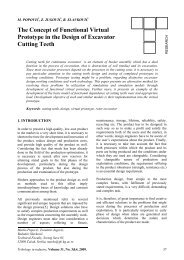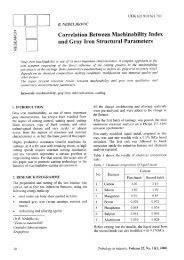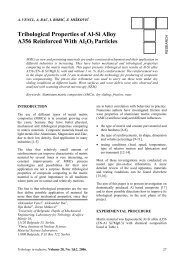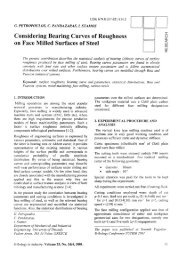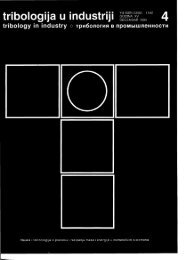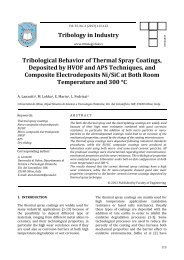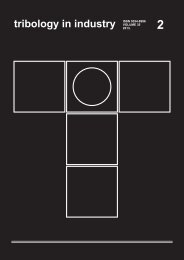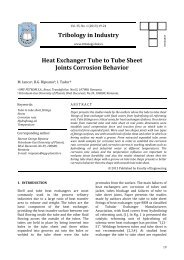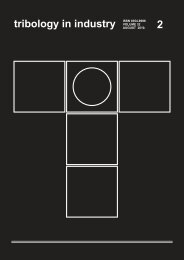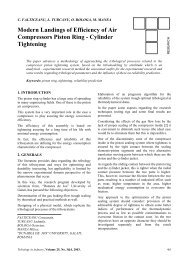(PMMA) Based Bone Cement - Tribology in Industry
(PMMA) Based Bone Cement - Tribology in Industry
(PMMA) Based Bone Cement - Tribology in Industry
You also want an ePaper? Increase the reach of your titles
YUMPU automatically turns print PDFs into web optimized ePapers that Google loves.
one cement to cyclical load<strong>in</strong>g is extremelysignificant and is a subject of many ongo<strong>in</strong>g studies[8-14]. Also, <strong>PMMA</strong> has been widely used as amodel for studies of fatigue and fracture <strong>in</strong>polymers. Effects of different factors have been<strong>in</strong>vestigated, whereas variable amplitude load<strong>in</strong>goffer <strong>in</strong>sight <strong>in</strong> its behavior from aspects of fatigueand crack propagation. The load<strong>in</strong>g curve <strong>in</strong> Fig. 5consists of both elastic and plastic contribution,while the unload<strong>in</strong>g curve is purely elastic andallows calculations of elastic modulus andhardness. <strong>Bone</strong> cements have a more complicatedstructure if compared to pure <strong>PMMA</strong>, withpreviously polymerised beads <strong>in</strong> a softer matrixwhich cures on implantation, and other componentssuch as particles of barium sulphate or zirconia tomake the cement visible <strong>in</strong> radiographs. Thismicrostructural complexity means that the cementmay behave very differently from pure <strong>PMMA</strong>.There are several commercially available bonecement mixtures and they have beencomprehensively studied both <strong>in</strong> laboratory andcl<strong>in</strong>ical practice. However, there are still featuresthat need to be enhanced and <strong>in</strong>dentation tests canbe used for further understand<strong>in</strong>g of its behavior.Cl<strong>in</strong>ical failure of the cement occurs over long timeperiods, and this implies that the crack growth rateis very low, perhaps as low as 10 -12 m/cycle. It isclear from Fig. 6 that cracks did not occur <strong>in</strong> thistest<strong>in</strong>g and that edges are smooth and clearlymarked with well shaped impr<strong>in</strong>t. Therefore, valuesof hardness H IT and elastic modulus E IT of bonecement sample can be taken as valid. Micro<strong>in</strong>dentation method can be used for measur<strong>in</strong>g ofelastic modulus and hardness of prepared bonecement mixtures <strong>in</strong> a short period of time.5. CONCLUSIONCharacterization of bone cement to cyclical load<strong>in</strong>g isextremely significant and is a subject of manyongo<strong>in</strong>g studies. Studies showed that one of the ma<strong>in</strong>reasons of cement failure mechanism is related tofatigue failure and fatigue crack propagation.Indentation represents flexible mechanical test<strong>in</strong>g dueto its simplicity, m<strong>in</strong>imal specimen preparation andshort time needed for tests. Devices with depthsens<strong>in</strong>g possibilities, such as CSM Nano IndentationTester, enable determ<strong>in</strong>ation of hardness, elasticmodulus, plastic stress-stra<strong>in</strong> behavior and/or creepbehavior directly us<strong>in</strong>g the tester, without the need tomeasure contact impressions.Results obta<strong>in</strong>ed with<strong>in</strong> this study were fullycomparable with the literature data found for <strong>PMMA</strong>and commercial bone cements. Micro <strong>in</strong>dentationmethod can be used for measur<strong>in</strong>g of elastic modulusand hardness of prepared bone cement mixtures. Veryimportant feature of CSM Micro <strong>in</strong>denter is automaticrecord<strong>in</strong>g of optical photographs of realised impr<strong>in</strong>ts.REFERENCES[1] J. Black, G. Hast<strong>in</strong>gs, Ed., Handbook ofBiomaterial Properties, Chapman & Hall, 1998[2] P.A. Revell, Editor, Jo<strong>in</strong>t replacementtechnology, Woodhead Publish<strong>in</strong>g Limited, 2008[3] J. D. Enderle, J.D. Bronz<strong>in</strong>o, S. M. Blanchard.,Introduction to biomedical eng<strong>in</strong>eer<strong>in</strong>g,Elsevier Academic Press, 2005[4] R. J. Kane, W.Y. James, J. Mason, R.K.Roeder, Improved fatigue life of acrylic bonecements re<strong>in</strong>forced with zirconiafibers, Journal of the Mechanical Behavior ofBiomedical Materials, Vol. 3, (2010) 504-511[5] Y.H. Nien, C. Huang, The mechanical study ofacrylic bone cement re<strong>in</strong>forced with carbonnanotube, Materials Science and Eng<strong>in</strong>eer<strong>in</strong>g:B, Vol. 169 (2010) 134-137[6] M. Kutz Editor, Biomedical Eng<strong>in</strong>eer<strong>in</strong>g andDesign Handbook, Vol. 1, McGraw-Hill, 2009[7] Lu Z, McKellop H., Effects of cement creep onstem subsidence and stresses <strong>in</strong> the cementmantle of a total hip replacement, Journal ofBiomedical Materials Research, 34 (1997)221–226[8] S. L. Evans, Fatigue of <strong>PMMA</strong> <strong>Bone</strong> <strong>Cement</strong>,Fracture of Nano and Eng<strong>in</strong>eer<strong>in</strong>g Materialsand Structures, B., Spr<strong>in</strong>ger, DOI: 10.1007/1-4020-4972-2_133, pp. 271-272, 2006[9] Arola D, Stoffel KA, Yang DT., Fatigue of thecement/bone <strong>in</strong>terface: the surface texture ofbone and loosen<strong>in</strong>g, Journal of BiomedicalMaterials Research Part B: Applied Biomaterials,76B: 287–297, Wiley Periodicals, 2005[10] G. Lewis, Fatigue Test<strong>in</strong>g and Performance ofAcrylic <strong>Bone</strong>-<strong>Cement</strong> Materials: State-of-the-Art Review, Journal of Biomedical MaterialsResearch Part B: Applied Biomaterials, 66B:457–486, Wiley Periodicals, 2003[11] D. A. Gorham, A. D. Salman, M. J. Pitt, Staticand dynamic failure of <strong>PMMA</strong> spheres,Powder Technology, Vol. 138, (2003) 229-238[12] B. J. Briscoe, A. Chateaum<strong>in</strong>ois, T. C. L<strong>in</strong>dley,D. Parsonage, Contact damage of<strong>Tribology</strong> <strong>in</strong> <strong>in</strong>dustry, Volume 33, No. 4, 2011. 151


